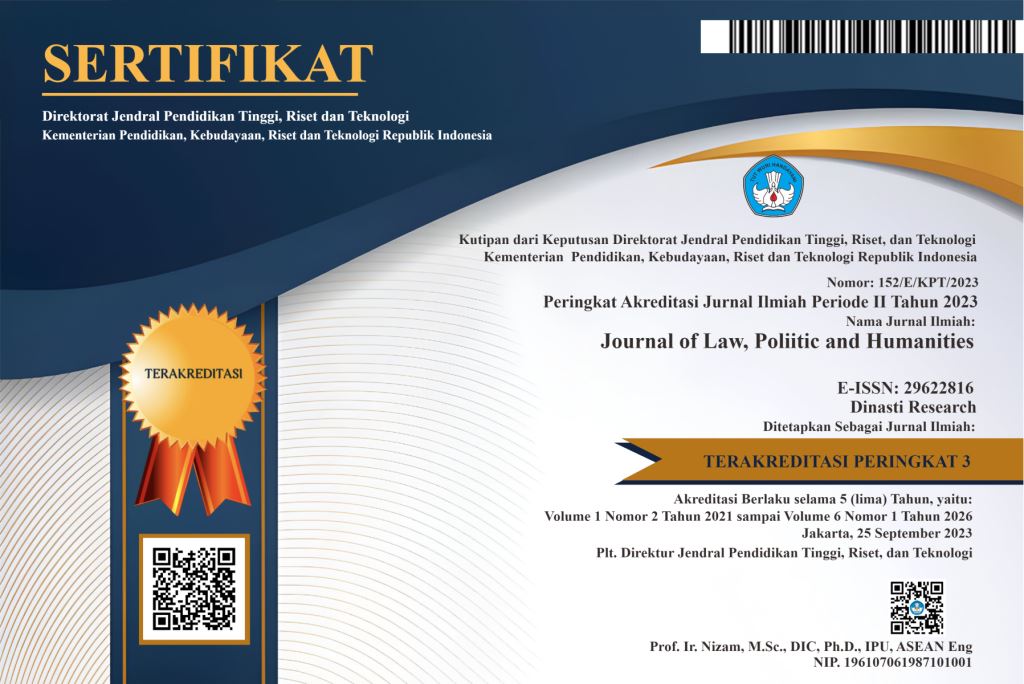Fulfillment of the Constitutional Rights of Persons with Disabilities to Employment Opportunities in the Banking Industry of State-Owned Enterprises
DOI:
https://doi.org/10.38035/jlph.v4i6.604Keywords:
Disability, Human Rights, Employment Rights, State-Owned Enterprises, Banking IndustryAbstract
Employment is one of many important aspect in the area of human rights protection. Indonesia’s citizens have the right to work and a decent livelihood, including people with disabilities. As one of the efforts to enhance opportunities to improve the welfare of persons with disabilities, Indonesian Law Number 8 of 2016 on Persons with Disabilities was formulated, which contains various arrangements regarding the rights of persons with disabilities and the State’s obligations to fulfill those rights. This study aimed to provide an overview of these regulation’s fulfillment, especially that related to equal employment opportunities for persons with disabilities, with a particular focus on the banking industry within SOEs. This study employs a non-doctrinal, descriptive-analytical approach to analyze Law No. 8/2016 on Persons with Disabilities, focusing on Article 53(1) regarding workforce representation in state-owned enterprises. Data is gathered through literature reviews and stakeholder interviews, using qualitative analysis to evaluate legal norms and provide a comprehensive understanding of the legal context. The finding revealed that the state plays a crucial regulatory role in protecting the rights of persons with disabilities, yet the implementation of Article 53(1) of Law No. 8/2016 has been inadequate, resulting in less than 0.5% representation in BUMN banks against the mandated 2%. To improve compliance, both the state and companies must prioritize recruitment and create inclusive opportunities for persons with disabilities.
References
Adnan, I. M. (2017). Hukum Konstitusi di Indonesia. Trussmedia Grafika.
Alkostar, A. (2010). Penegakan Hukum Kasus HAM. Makalah Mata Kuliah Sistem Perlindungan HAM di Magister Fakultas Hukum UII.
Arinanto, S. (2001). Politik Hukum 2. Pascasarjana Fakultas Hukum Indonesia.
Aristoteles. (1997). Teori Keadilan Dalam Perspektif Hukum, Cet. 2 (2nd ed.). Sinar Grafika.
AshShiddiqie, J. (2009). Menuju Negara Hukum yang Demokratis. Jakarta: PT. Bhuana Ilmu Populer.
Asshiddiqie, J. (2007). Pokok-Pokok Hukum Tata Negara Indonesia Pasca Reformasi. In Bhuana Ilmu Populer.
Azhary, M. T. (1992). Negara Hukum (1st ed.). Bulan Bintang.
Bank BNI. (2023). Laporan Tahunan Bank BNI Tahun 2022. Bank BNI.
Bank Mandiri. (2023). Laporan Tahunan Bank Mandiri 2022.
BRI. (2022). Laporan Tahunan Bank BRI Tahun 2022.
BTN. (2023). Struktur Organisasi.
Budiardjo, M. (1972). Dasar-Dasar Ilmu Politik. Gramedia Pustaka Utama.
Budiati. (2020). Indikator Kesejahteraan Rakyat 2020: Welfare Indicators.
Donnelly, J. (2013). Universal human rights in theory and practice. Cornell University Press.
Efendi, M. (2006). Pengantar psikopedagogik anak berkelainan.
El-Muhtaj, M. (2017). Hak asasi manusia dalam konstitusi Indonesia. Prenada Media.
FHCI. (2023). Pedoman Operasional Asistensi Rehabilitasi Sosial Penyandang Diabilitas. https://www.fhcibumn.com/ Kementerian Sosial RI.
Hadjon, P. M. (1993). Pengantar Hukum Perizinan. Yuridika.
Hutabarat, D. T. H., Salam, A., Zuwandana, A., Al Azmi, C., Wijaya, C. R., Darnita, Tania, I., Lubis, L. K. A., Sitorus, M. A. P., Adawiyah, R., & Sinaga, R. (2022). Analysis Of The Implementation Of Law In Every Level Of Society In Indonesia. POLICY, LAW, NOTARY AND REGULATORY ISSUES (POLRI). https://doi.org/https://doi.org/10.55047/polri.v1i2.80
Kementerian Sosial RI. (2020). Pedoman Operasional Asistensi Rehabilitasi Sosial Penyandang Diabilitas.
Kusnardi. (2000). Ilmu Negara Edisi Revisi. Gaya Media Pratama.
Lubis, T. M. (1990). In Search of Human Rights: Legal-political Dilemmas of Indonesia’s New Order, 1966-1990. University of California, Berkeley.
Lubis, T. M. (2002). “Jaminan Konstitusi Atas Hak Asasi Manusia dan Kebebasan” dalam International IDEA, Melanjutkan Dialog Menuju Reformasi Konstitusi di Indonesia.
Mezak, M. H. (2006). Jenis, Metode dan Pendekatan Dalam Penelitian Hukum. Law Review, 5(3), 85–97. https://www.academia.edu/download/33676150/lw-05-03-2006-jenis_metode_dan_pendekatan.pdf
Muhaimin. (2020). Metode Penelitian Hukum. Mataram University Press.
Nugroho, S., & Utami, R. (2004). Meretas Siklus Kecacatan Siklus Yang terabaikan. Surakarta: Yayasan Talenta.
Simorangkir, J. C. T. (1983). Hukum dan Konstitusi Indonesia. Gunung Agung.
Smith, R. K. M., Asplund, K. D., & Marzuki, S. (2008). Hukum hak asasi manusia. Pusat Studi Hak Asasi Manusia, Universitas Islam Indonesia (PUSHAM UII).
Soekanto, S. (2006). Pengantar penelitian hukum. Penerbit Universitas Indonesia (UI-Press).
WHO. (2023). Disability. World Health Organization. https://www.who.int/news-room/fact-sheets/detail/disability-and-health
Wignjosoebroto, S. (2002). Hukum: Paradigma, metode dan dinamika masalahnya. (No Title).
Downloads
Published
How to Cite
Issue
Section
License
Copyright (c) 2024 Nastitie Kusuma Anggraini, Heru Susetyo

This work is licensed under a Creative Commons Attribution 4.0 International License.
Authors who publish their manuscripts in this journal agree to the following conditions:
- The copyright on each article belongs to the author(s).
- The author acknowledges that the Journal of Law, Poliitic and Humanities (JLPH) has the right to be the first to publish with a Creative Commons Attribution 4.0 International license (Attribution 4.0 International (CC BY 4.0).
- Authors can submit articles separately, arrange for the non-exclusive distribution of manuscripts that have been published in this journal into other versions (e.g., sent to the author's institutional repository, publication into books, etc.), by acknowledging that the manuscript has been published for the first time in the Journal of Law, Poliitic and Humanities (JLPH).


























